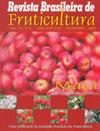Phenology and viticultural performance of different fungus-resistant grapevine advanced selections at three different altitudes in southern Brazil
IF 0.9
4区 农林科学
Q4 HORTICULTURE
引用次数: 1
Abstract
Abstract The objective of this work was to characterize the phenology and the viticultural performance of advanced selections of grapevines resistant to fungal diseases obtained by the Julius Kühn Institute, Institute for Grapevine Breeding Geilweilerhof. The experiment was conducted in three different grape-growing regions of Santa Catarina State, Brazil, in the municipalities of Videira (840 m), São Joaquim (1110 m) and Curitibanos (1000 m) during the seasons of 2018/2019 and 2019/2020. The advanced selections evaluated were the reds Gf.2004-043-0010 (Gf.10), Gf.2004-043-0013 (Gf.13), Gf.2004-043-0021(Gf.21) and the white Gf.2004-043-0004 (Gf.04). We found that pyramided loci Rpv1+Rpv3.1 and Run1+Ren3 were present, which confer resistance to downy mildew and powdery mildew, respectively. The phenological stages events evaluated were budbreak, full bloom, veraison and maturity. The productive variables evaluated were fertility index, number of clusters, cluster weight and yield. Technological maturity parameters were soluble solids, total acidity and pH. To understand the relationship between the variables and whether these relationships changed depending on the cultivation environment the Multi-Trait Genotype–Ideotype Distance Index was used to rank the genotypes based on the analyzed traits. For most selections, the budbreak occurred in the second half of September; full bloom occurred from late October to mid-November; the veraison occurred between the end of December and mid-January; and maturity occurred between the end of January and February. The earliest budbreak occurred in the vineyard located at the highest altitude (1110 m - São Joaquim), while the earliest full bloom, veraison and maturity occurred in the lowest altitude vineyard (840 m – Videira). All selections produced grapes with adequate concentrations of pH and total acidity to produce quality wines. Except for Gf.13, all selections produced grapes with levels of soluble solids suitable to produce quality wines. Based on the Multi-Trait Genotype–Ideotype Distance Index (MGIDI) the selections Gf.13 and Gf.10 are the most promising genotypes for the Videira region (840 m) and Gf.10 is the most promising genotype for the regions of higher altitude, 1000 m and 1110 m.巴西南部三个不同海拔地区不同抗真菌葡萄高级选种的物候和葡萄栽培性能
摘要/ Abstract摘要:本研究的目的是研究由Julius k研究所和Geilweilerhof葡萄育种研究所获得的葡萄抗真菌病高级选育品种的物候特征和葡萄栽培性能。实验在巴西圣卡塔琳娜州的三个不同的葡萄种植区进行,分别是维迪拉市(840米)、s o Joaquim市(1110米)和库里提巴诺斯市(1000米),分别于2018/2019和2019/2020年进行。评价的高级品种为红色品种Gf.2004-043-0010 (Gf.10)、Gf.2004-043-0013 (Gf.13)、Gf.2004-043-0021(Gf.21)和白色品种Gf.2004-043-0004 (Gf.04)。结果发现,水稻对霜霉病和白粉病具有抗性的基因座分别为Rpv1+Rpv3.1和Run1+Ren3。评价的物候阶段事件为花蕾期、花期、花期和成熟期。评价的生产变量为肥力指数、簇数、簇重和产量。技术成熟度参数为可溶性固形物、总酸度和ph。为了了解这些变量之间的关系以及这些关系是否随栽培环境的变化而变化,采用多性状基因型-理想型距离指数(Multi-Trait Genotype-Ideotype Distance Index)对分析性状进行基因型排序。对于大多数品种来说,发芽发生在9月的下半月;花期为10月下旬至11月中旬;发生在12月底至1月中旬之间;在1月底到2月底之间到期。最高海拔的葡萄园(1110 m - o Joaquim)最早发芽,而最低海拔的葡萄园(840 m - Videira)最早开花、变熟和成熟。所有选择生产的葡萄具有足够的pH值和总酸度浓度,以生产优质葡萄酒。除Gf.13外,所有品种的葡萄都具有适合生产优质葡萄酒的可溶性固体含量。基于多性状基因型-理想型距离指数(MGIDI),选择Gf.13和Gf.10是vidira地区(840 m)最有希望的基因型,选择Gf.10是海拔较高地区(1000 m和1110 m)最有希望的基因型。
本文章由计算机程序翻译,如有差异,请以英文原文为准。
求助全文
约1分钟内获得全文
求助全文
来源期刊
CiteScore
1.50
自引率
20.00%
发文量
34
审稿时长
4-8 weeks
期刊介绍:
The Revista Brasileira de Fruticultura (RBF) publishes technical articles and scientific communications in the area of fruit crops, referring to results of original searches and unpublished papers in Portuguese, Spanish or English, and 1 or 2 reviews per edition, of invited authors.

 求助内容:
求助内容: 应助结果提醒方式:
应助结果提醒方式:


